Adaptive Feature Enhancement Network for Semantic Segmentation
Semantic segmentation is a fundamental and challenging problem in computer vision. Recent studies attempt to integrate feature information of different depths to improve the performance of segmentation tasks, and a few of them enhance the features before
- PDF / 91,474,099 Bytes
- 863 Pages / 439.37 x 666.142 pts Page_size
- 30 Downloads / 398 Views
rmation Processing 27th International Conference, ICONIP 2020 Bangkok, Thailand, November 18–22, 2020 Proceedings, Part IV
Communications in Computer and Information Science Editorial Board Members Joaquim Filipe Polytechnic Institute of Setúbal, Setúbal, Portugal Ashish Ghosh Indian Statistical Institute, Kolkata, India Raquel Oliveira Prates Federal University of Minas Gerais (UFMG), Belo Horizonte, Brazil Lizhu Zhou Tsinghua University, Beijing, China
1332
More information about this series at http://www.springer.com/series/7899
Haiqin Yang Kitsuchart Pasupa Andrew Chi-Sing Leung James T. Kwok Jonathan H. Chan Irwin King (Eds.) •
•
•
•
•
Neural Information Processing 27th International Conference, ICONIP 2020 Bangkok, Thailand, November 18–22, 2020 Proceedings, Part IV
123
Editors Haiqin Yang Department of AI Ping An Life Shenzhen, China Andrew Chi-Sing Leung City University of Hong Kong Kowloon, Hong Kong Jonathan H. Chan School of Information Technology King Mongkut’s University of Technology Thonburi Bangkok, Thailand
Kitsuchart Pasupa Faculty of Information Technology King Mongkut's Institute of Technology Ladkrabang Bangkok, Thailand James T. Kwok Department of Computer Science and Engineering Hong Kong University of Science and Technology Hong Kong, Hong Kong Irwin King The Chinese University of Hong Kong New Territories, Hong Kong
ISSN 1865-0929 ISSN 1865-0937 (electronic) Communications in Computer and Information Science ISBN 978-3-030-63819-1 ISBN 978-3-030-63820-7 (eBook) https://doi.org/10.1007/978-3-030-63820-7 © Springer Nature Switzerland AG 2020 This work is subject to copyright. All rights are reserved by the Publisher, whether the whole or part of the material is concerned, specifically the rights of translation, reprinting, reuse of illustrations, recitation, broadcasting, reproduction on microfilms or in any other physical way, and transmission or information storage and retrieval, electronic adaptation, computer software, or by similar or dissimilar methodology now known or hereafter developed. The use of general descriptive names, registered names, trademarks, service marks, etc. in this publication does not imply, even in the absence of a specific statement, that such names are exempt from the relevant protective laws and regulations and therefore free for general use. The publisher, the authors and the editors are safe to assume that the advice and information in this book are believed to be true and accurate at the date of publication. Neither the publisher nor the authors or the editors give a warranty, expressed or implied, with respect to the material contained herein or for any errors or omissions that may have been made. The publisher remains neutral with regard to jurisdictional claims in published maps and institutional affiliations. This Springer imprint is published by the registered company Springer Nature Switzerland AG The registered company address is: Gewerbestrasse 11, 6330 Cham, Switzerland
Preface
This book is a part of the five-volume proceedings of the 27t











